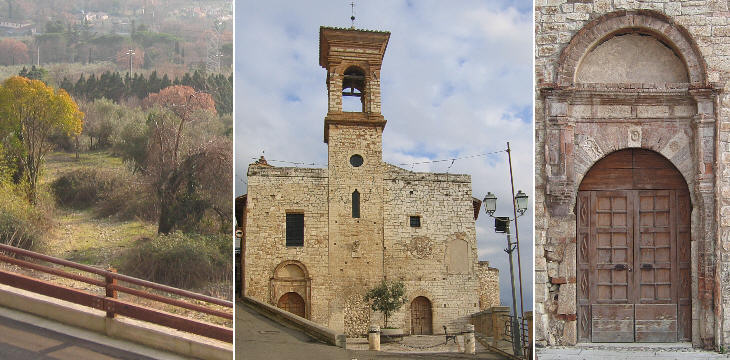
All images © by Roberto Piperno, owner of the domain. Write to romapip@quipo.it.
Notes:
Page revised in November 2020.

All images © by Roberto Piperno, owner of the domain. Write to romapip@quipo.it.
Notes:
Page revised in November 2020.
 page one: Cesi
page one: Cesi

(left) Blue line: National Railway (Ferrovie dello Stato) from Rome to Perugia; red line: Central Umbrian Railway (Ferrovia Centrale Umbria) from Terni to Perugia; (right) waiting for the train at Acquasparta
Japan and France are known for their high-speed trains which link their major cities; most European countries (including Italy) have developed a net of fast trains too. The services provided by Ferrovia Centrale Umbra can hardly be regarded as falling into this category of rail transport. Yet the two-coach train linking Terni with Perugia via Todi, has the charm of the good ol' days, when travellers watched the countryside they were crossing, rather than toying with cellular phones and the likes.
Furthermore the Umbrian landscape is well worth being paid attention to!
The next morning, by virtue of an arrangement previously concluded, I was driven over from Terni to San Gemini, a small village about ten miles off, in order to take a diligence which passed through there on the way to Perugia; and, to make sure of the time, I was obliged to start at five. The wagon provided for me was primitive (..) but, had it been a wheelbarrow, I should not have murmured, so beautiful was the region through which it carried me. (..) The road ran through fresh and dewy woods, and over upland ridges from which the eye ranged over many a league of plain. It was a great delight to mark the various portions of the landscape struggling out of the darkness and glowing into day,to see the long wave of morning gold climb up the gray beach of the eastern sky, and overflow the valleys. (..) There were very few houses on the road, but we met many laborers, some singly and some in groups, going out to their daily toil.
George Stillman Hillard - Six Months in Italy in 1847-1848

While National Railway trains leave Terni (towards Perugia) in a north-eastern direction, those of Ferrovia Centrale Umbra go north-west and they soon reach a territory which belonged to the Cesi. This family is mainly known for Federico II Cesi (1585-1630), Duke of Acquasparta, the founder of Accademia dei Lincei, who protected Galileo Galilei and who preached that scientists (and more in general all men) should be allowed to develop their researches in naturalibus (in natural phenomena), without limits and constraints. At Academy meetings, Federico Cesi was called Coelivagus (fond of the sky) because of his interest in astronomy.

View of Cesi from San Gemini
Cesi lies on the slope of a hill having a commanding view over the River Nera valley from Terni to Narni. Outside the small town there are very old polygonal walls and terraces of Roman villas. Cesi most likely means cut (trees) an indication that part of a wood was cut to make room for the first buildings; the coat of arms of the Cesi family shows a mountain having on top a tree, a reference to the town location and its being surrounded by woods (you can see it in the image used as background for this page).

(left) Path linking Cesi to the lowland; (centre) S. Angelo; (right) S. Angelo: main portal
Today two winding roads link the small railway station in the valley with the town: in the past there were paths which cut through the woods (or the olive-groves).
S. Angelo is a medieval church which in the XVIth century was enlarged and it incorporated an existing tower; both the belfry and the portal belong to that period.

(left) Bridge linking the two sides of Palazzo Cesi; (centre) one of the two portals of Palazzo Cesi; (right) the portal of another Renaissance building
The Cesi family palace is a rather small building; its two identical portals facing each other have a simple, but very elegant design. Also other buildings have fine Renaissance portals. The Cesi had several palaces in Rome and a fine collection of antiquities.

(left): S. Andrea: fragments of sarcophagi from Carsulae, a Roman town; (centre) S. Agnese; (right) S. Maria Assunta: a Baroque altar
Cesi retains memories of its long past: from the fragments of early Christian sarcophagi which decorate the walls of S. Andrea to Baroque churches and altars.

Wandering in the streets of Cesi
Move to page two: San Gemini and Acquasparta.

